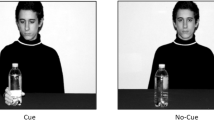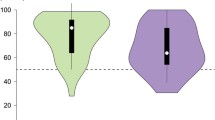Abstract
Thirteen autistic children were compared to 13 normal children, matched to them in mental age, on performance of a visual discrimination task. Form, color, and size were relevant and redundant cues. The groups did not differ significantly in mean trials to reach criterion or in breadth of learning, and both groups increased their breadth of learning after 50 trials of overtraining. Form was preferred to color and size by both autistic and normal children. Within each group, rank on mental age was highly correlated with rank in breadth of learning. Verbal and nonverbal autistic children did not differ in breadth of learning or in dimensional preference. Even nonverbal autistics equaled the performance of their normal controls. Our results suggest that overselective attention is better understood as part of a general developmental lag in cognition in autistic children than as a specific deficit underlying psychotic behavior.
Similar content being viewed by others
References
Eimas, P. D. Multiple-cue discrimination learning in children.Psychological Record, 1969,19, 417–424.
Fisher, M. A., & Zeaman, D. An attention-retention theory of retardate discrimination learning. In N. B. Ellis (Ed.),International review of research in mental retardation (Vol. 6). New York: Academic Press, 1973. Pp. 171–251.
Garner, W. R. The stimulus in information processing.American Psychologist, 1970,25, 350–358.
Hale, G. A., & Morgan, J. S. Developmental trends in children's component selection.Journal of Experimental Child Psychology, 1973,75, 302–314.
Hale, G. A., & Piper, R. A. Developmental trends in children's incidental learning: Some critical stimulus differences.Developmental Psychology, 1973,8, 327–335.
Hale, G. A., & Taweel, S. S. Children's component selection with varying degrees of training.Journal of Experimental Child Psychology, 1974,17, 229–241.
Keppel, G.Design and analysis: A researcher's handbook. Englewood Cliffs, New Jersey: Prentice-Hall, 1973.
Koegel, R. L., & Wilhelm, H. Selective responding to the components of multiple visual cues by autistic children.Journal of Experimental Child Psychology, 1973,15, 442–453.
Kovattana, P. M., & Kraemer, H. C. Response to multiple visual cues of color, size and form by autistic children.Journal of Autism and Childhood Schizophrenia, 1974,4, 251–261.
Lovaas, O. I., & Newsom, C. D. Behavior modification with psychotic children. In H. Leitenberg (Ed.),Handbook of behavior modification and behavior therapy. Englewood Cliffs, New Jersey: Prentice-Hall, 1976.
Lovaas, O. I., & Schreibman, L. Stimulus over selectivity of autistic children in a two stimulus situation.Behavior Research and Therapy, 1971,9, 305–310.
Lovaas, O. I., Schreibman, L., Koegel, R., & Rehm, R. Selective responding by autistic children to multiple sensory input.Journal of Abnormal Psychology, 1971,77, 211–222.
Rimland, B.infantile autism. New York: Appleton-Century-Crofts, 1964.
Schreibman, L., & Lovaas, O. I. Overselective response to social stimuli by autistic children.Journal of Abnormal Child Psychology, 1973,1, 152–168.
Shepp, B. E., Kemler, D. G., & Anderson, D. R. Selective attention and the breadth of learning: An extension of the one-look model.Psychological Review, 1972,79, 317–328.
Sutherland, N. S. Partial reinforcement and breadth of learning.The Quarterly Journal of Experimental Psychology, 1966,18, 289–301.
Sutherland, N. S., & Holgate, V. Two-cue discrimination learning in rats.Journal of Comparative and Physiological Psychology, 1966,61, 198–207.
Trabasso, T., & Bower, G. H.Attention in learning. New York: Wiley & Sons, 1968.
Wilhelm, H., & Lovaas, O. I. Stimulus over selectivity: A common feature in autism and mental retardation.American Journal of Mental Deficiency, 1976,81, 227–241.
Author information
Authors and Affiliations
Additional information
This research was supported in part by NIMH Grant 11440, O. I. Lovaas, principal investigator. The authors thank Dr. Lovaas and Dennis C. Russo for their helpful criticisms of an earlier draft.
Rights and permissions
About this article
Cite this article
Schover, L.R., Newsom, C.D. Overselectivity, developmental level, and overtraining in autistic and normal children. J Abnorm Child Psychol 4, 289–298 (1976). https://doi.org/10.1007/BF00917765
Revised:
Issue Date:
DOI: https://doi.org/10.1007/BF00917765




